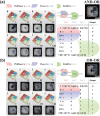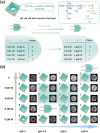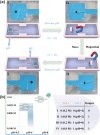Untethered Soft Microrobots with Adaptive Logic Gates
- PMID: 36809583
- PMCID: PMC10161047
- DOI: 10.1002/advs.202206662
Untethered Soft Microrobots with Adaptive Logic Gates
Abstract
Integrating adaptative logic computation directly into soft microrobots is imperative for the next generation of intelligent soft microrobots as well as for the smart materials to move beyond stimulus-response relationships and toward the intelligent behaviors seen in biological systems. Acquiring adaptivity is coveted for soft microrobots that can adapt to implement different works and respond to different environments either passively or actively through human intervention like biological systems. Here, a novel and simple strategy for constructing untethered soft microrobots based on stimuli-responsive hydrogels that can switch logic gates according to the surrounding stimuli of environment is introduced. Different basic logic gates and combinational logic gates are integrated into a microrobot via a straightforward method. Importantly, two kinds of soft microrobots with adaptive logic gates are designed and fabricated, which can smartly switch logic operation between AND gate and OR gate under different surrounding environmental stimuli. Furthermore, a same magnetic microrobot with adaptive logic gate is used to capture and release the specified objects through the change of the surrounding environmental stimuli based on AND or OR logic gate. This work contributes an innovative strategy to integrate computation into small-scale untethered soft robots with adaptive logic gates.
Keywords: adaptive logic gates; conjugated logic gates; soft microrobots; stimuli-responsive hydrogels.
© 2023 The Authors. Advanced Science published by Wiley-VCH GmbH.
Conflict of interest statement
The authors declare no conflict of interest.
Figures






Similar articles
-
Small-scale soft grippers with environmentally responsive logic gates.Mater Horiz. 2022 May 10;9(5):1431-1439. doi: 10.1039/d2mh00097k. Mater Horiz. 2022. PMID: 35380150
-
Performing Logical Operations with Stimuli-Responsive Building Blocks.Adv Mater. 2017 May;29(18). doi: 10.1002/adma.201606483. Epub 2017 Mar 1. Adv Mater. 2017. PMID: 28247973
-
Supramolecular hydrogel exhibiting four basic logic gate functions to fine-tune substance release.J Am Chem Soc. 2009 Apr 22;131(15):5580-5. doi: 10.1021/ja8098239. J Am Chem Soc. 2009. PMID: 19331364
-
Fluorescence for biological logic gates.J Biophotonics. 2020 Sep;13(9):e202000158. doi: 10.1002/jbio.202000158. Epub 2020 Jun 29. J Biophotonics. 2020. PMID: 32537894 Review.
-
Bioinspired soft microrobots actuated by magnetic field.Biomed Microdevices. 2021 Oct 1;23(4):52. doi: 10.1007/s10544-021-00590-z. Biomed Microdevices. 2021. PMID: 34599405 Review.
Cited by
-
Sub-Nanogram Resolution Measurement of Inertial Mass and Density Using Magnetic-Field-Guided Bubble Microthruster.Adv Sci (Weinh). 2024 Aug;11(29):e2403867. doi: 10.1002/advs.202403867. Epub 2024 May 22. Adv Sci (Weinh). 2024. PMID: 38773950 Free PMC article.
-
Light-Controlled Soft Switches for Optical Logic Gate Operations.Sensors (Basel). 2025 Mar 25;25(7):2051. doi: 10.3390/s25072051. Sensors (Basel). 2025. PMID: 40218563 Free PMC article.
References
-
- Liu D., Wang T., Lu Y., Adv. Healthcare Mater. 2022, 11, 2102253. - PubMed
-
- Soto F., Karshalev E., Zhang F., Fernandez de Avila B. E., Nourhani A., Wang J., Chem. Rev. 2021, 122, 5365. - PubMed
-
- Chen X.‐Z., Liu J.‐H., Dong M., Müller L., Chatzipirpiridis G., Hu C., Terzopoulou A., Torlakcik H., Wang X., Mushtaq F., Mater. Horiz. 2019, 6, 1512.
Grants and funding
- 52003220/National Natural Science Foundation of China
- G2019KY05109/Fundamental Research Funds for the Central Universities
- G2020KY05303/Fundamental Research Funds for the Central Universities
- 2020M673480/China Postdoctoral Science Foundation
- 2020JQ-140/Natural Science Basic Research Program of Shaanxi Province
LinkOut - more resources
Full Text Sources
